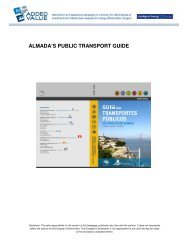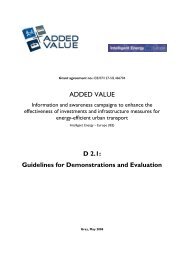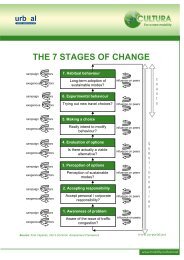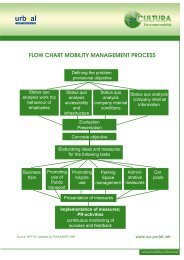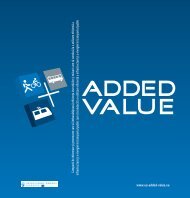SUMO - Eltis
SUMO - Eltis
SUMO - Eltis
Create successful ePaper yourself
Turn your PDF publications into a flip-book with our unique Google optimized e-Paper software.
7. Drawing up indicators and methods for<br />
the different analysis levels<br />
7.1 INDICATORS THAT ASSIST UNDERSTANDING<br />
It is often difficult in practice to directly measure travel habits and the impact on traffic<br />
for different measures. Indicators can be used instead. Indicators are data that are<br />
easy to measure and have been chosen or compiled to illustrate changes that cannot be<br />
measured directly.<br />
Indicators are specified for each planned service and target group and for each of the<br />
analysis levels. Indicators are chosen to be consistent with the defined targets. For some<br />
levels and targets it is sufficient to register or measure numbers, while for others it may<br />
be better to describe indicators in terms of a percentage. The method or methods used<br />
to collect data is to be stated for each indicator.<br />
It is not possible only to focus on quantifying changes, such as the number of motorised<br />
kilometres. It is also important to study why these changes have taken place. This<br />
means the list of indicators should also include reasons for the changes in behaviour.<br />
Indicators used are slightly different for city-wide and site-specific projects.<br />
7.2 METHODS FOR COLLECTING DATA<br />
A large amount of different types of data can be interesting to study. However, data<br />
collection requires extensive effort and is often expensive. It is therefore important to<br />
carefully identify which data are necessary for monitoring and evaluation of the project<br />
for the chosen indicators. Before starting a project, one should carefully think through<br />
which behavioural measurements are required before the project begins. This is<br />
necessary to compare and measure the effects of implemented measures.<br />
In principle, data collection should be carried out regularly (each year, month, week<br />
etc.) in order to monitor changes in user situation and behaviour, increased programme<br />
efficiency and the impact of this on the transport system. While planning the project<br />
one should decide how often data collection should take place. For the Test Traveller<br />
project, it is suitable to measure travel behaviour before the test period, during the test<br />
period, and 6 and 12 months afterwards. Documentation of useful achievements<br />
should be carried out continuously.<br />
INDICATORS AND METHODS<br />
sumo – System for Evaluation of Mobility Projects 25



